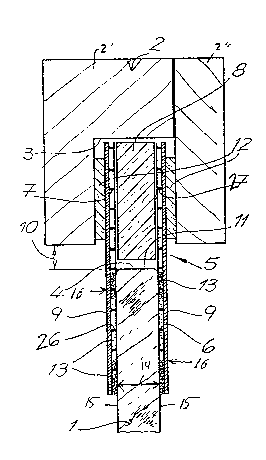Some of the information on this Web page has been provided by external sources. The Government of Canada is not responsible for the accuracy, reliability or currency of the information supplied by external sources. Users wishing to rely upon this information should consult directly with the source of the information. Content provided by external sources is not subject to official languages, privacy and accessibility requirements.
Any discrepancies in the text and image of the Claims and Abstract are due to differing posting times. Text of the Claims and Abstract are posted:
| (12) Patent Application: | (11) CA 2017977 |
|---|---|
| (54) English Title: | FIREPROOF MOUNTING ASSEMBLY FOR GLASS PANE |
| (54) French Title: | ENSEMBLE DE MONTAGE IGNIFUGE POUR PANNEAU VITRE |
| Status: | Deemed Abandoned and Beyond the Period of Reinstatement - Pending Response to Notice of Disregarded Communication |
| (51) International Patent Classification (IPC): |
|
|---|---|
| (72) Inventors : |
|
| (73) Owners : |
|
| (71) Applicants : | |
| (74) Agent: | BORDEN LADNER GERVAIS LLP |
| (74) Associate agent: | |
| (45) Issued: | |
| (22) Filed Date: | 1990-06-01 |
| (41) Open to Public Inspection: | 1990-12-03 |
| Availability of licence: | N/A |
| Dedicated to the Public: | N/A |
| (25) Language of filing: | English |
| Patent Cooperation Treaty (PCT): | No |
|---|
| (30) Application Priority Data: | ||||||
|---|---|---|---|---|---|---|
|
ABSTRACT
A glass pane has a pair of opposite faces and an outer edge and is held by
an adapter in a structural channel forming a groove. The adapter is formed in
part by respective metallic edge strips each having an inner portion overlying
a respective face of the pane and an outer portion projecting outward therefrom
and into the groove. The outer edge of the pane is spaced from the channel
and lies wholly outside the groove. Inner portions of the strips are secured
to the respective faces of the pane and a nonmetallic bar is secured between
the outer portions of the edge strips and engaged in the groove. The strips
are secured to the glass by an adhesive and each strip includes a perforate
under strip adhered to the glass and an imperforate cover strip adhered atop
the under strip. The adhesive has a silicone or water-glass base and is quite
resistant to heat.
PAT 15707-1
Note: Claims are shown in the official language in which they were submitted.
Note: Descriptions are shown in the official language in which they were submitted.

2024-08-01:As part of the Next Generation Patents (NGP) transition, the Canadian Patents Database (CPD) now contains a more detailed Event History, which replicates the Event Log of our new back-office solution.
Please note that "Inactive:" events refers to events no longer in use in our new back-office solution.
For a clearer understanding of the status of the application/patent presented on this page, the site Disclaimer , as well as the definitions for Patent , Event History , Maintenance Fee and Payment History should be consulted.
| Description | Date |
|---|---|
| Inactive: IPC from MCD | 2006-03-11 |
| Time Limit for Reversal Expired | 1994-12-01 |
| Application Not Reinstated by Deadline | 1994-12-01 |
| Deemed Abandoned - Failure to Respond to Maintenance Fee Notice | 1994-06-01 |
| Inactive: Adhoc Request Documented | 1994-06-01 |
| Application Published (Open to Public Inspection) | 1990-12-03 |
| Abandonment Date | Reason | Reinstatement Date |
|---|---|---|
| 1994-06-01 |
The last payment was received on
Note : If the full payment has not been received on or before the date indicated, a further fee may be required which may be one of the following
Please refer to the CIPO Patent Fees web page to see all current fee amounts.
| Fee Type | Anniversary Year | Due Date | Paid Date |
|---|---|---|---|
| MF (application, 2nd anniv.) - standard | 02 | 1992-06-01 |
Note: Records showing the ownership history in alphabetical order.
| Current Owners on Record |
|---|
| FLACHGLAS AKTIENGESELLSCHAFT |
| Past Owners on Record |
|---|
| None |